The important characteristics of semiconductor diodes are:
One or more of these characteristics may be of prime importance depending upon the diode. The main types of diodes used in electronic circuitry are:
These diodes are required to handle large currents and voltages. The usual requirements are a large reverse-resistance/forward-resistance ratio and a minimum of junction capacitance. Some of the commercially available Signal Diodes are listed as general-purpose diodes. A small signal diode is a small non-linear semiconductor which is often used in electronic circuits where high frequencies or small currents are involved in television, radio and digital logic circuits. Small signal diodes are smaller in size compared to regular power diodes. The PN junction of a small signal diode is usually encapsulated in glass in order to protect it and generally has a black or red band at one end of its body identifying it as the cathode end of the terminal. Small signal diodes have lower current and power ratings in comparison to rectifier diodes but can function better in high frequency applications or in switching and clipping applications which deal with short-duration pulse waveforms.
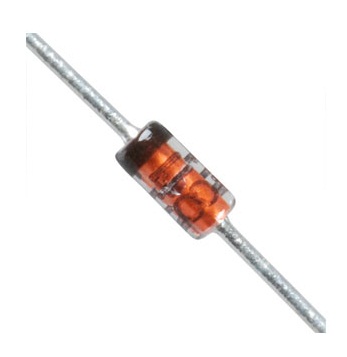
Power diodes are mostly used in rectifiers. The important parameters of a Power Diode are the peak inverse voltage, the maximum forward current, and the reverse-resistance/forward-resistance ratio. The peak inverse voltage rating is likely to be somewhere between 50 V and 1000 V. The maximum forward current may be perhaps 30 A, or even more. A power diode is a crystalline semiconductor device used mainly to convert alternating current (AC) to direct current (DC), a process known as rectification. Found in the power supply circuits of virtually all modern-day electrical and electronic equipment, a power diode's function is akin to a mechanical one-way valve. It conducts electric current with minimal resistance in one direction, known as its forward direction, while preventing current from flowing in the opposite direction. Typically capable of passing as much as several hundred amps forward, power diodes have much larger P-N junctions and hence higher forward current carrying capacity than their smaller signal diode relatives used in consumer electronics to regulate and reduce current.
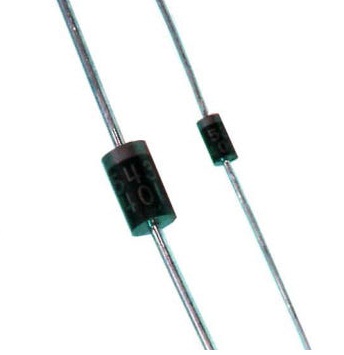
Zener diodes are designed to operate in the breakdown region without damage. By varying the doping level, it is possible to produce Zener Diodes with breakdown voltage from about 2V to 200 V. The large current at breakdown is brought about by two factors, known as the Zener and Avalanche effects. When a diode is heavily doped, the depletion layer is very narrow. When the voltage across the diode is increased the electric field across the depletion layer becomes very intense. Due to this effect electrons are pulled from the covalent bonds. A large number of electron-hole pairs are thus produced and the reverse current sharply increases. This is known as the Zener effect.
Avalanche effect occurs because of cumulative action. The external applied voltage stimulates the minority carriers in the depletion region. They obtain sufficient kinetic energy to ionize atoms by collision. This creates new electrons which are again accelerated to high-enough velocities to ionize more atoms. This way, an avalanche of free electrons is obtained. The reverse current sharply increases.
Zener diodes are a special kind of diode which permits current to flow in the forward direction. What makes them different from other diodes is that Zener diodes will also allow current to flow in the reverse direction when the voltage is above a certain value. This breakdown voltage is known as the Zener voltage. In a standard diode, the Zener voltage is high, and the diode is permanently damaged if a reverse current above that value is allowed to pass through it. Zener diodes are designed in a way where the Zener voltage is a much lower value. There is a controlled breakdown which does not damage the diode when a reverse current above the Zener voltage passes through a Zener diode.
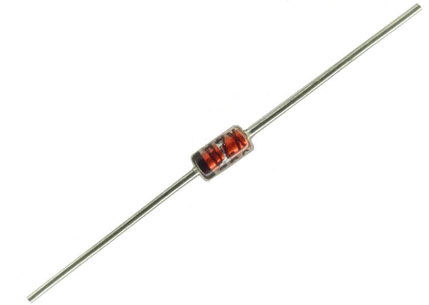
When a PN-junction diode is forward-biased, the potential barrier is lowered. The majority carriers start crossing the junction. The conduction-band electrons from the N region cross the barrier and enter the P region. Immediately on entering the P region, each electron falls into a hole and recombination takes place. Also, some holes may cross the junction from the P region into the N region. A conduction-band electron in the N region may fall into a hole even before it crosses the junction. Each recombination radiates energy. In an ordinary diode the radiated energy is in the form of heat. In the light-emitting diode, the radiated energy is in the form of light. By using materials such as gallium arsenide phosphide(GaAsp) and gallium phosphide(GaP), a manufacturer can produce LEDs that radiate red, green or orange lights.
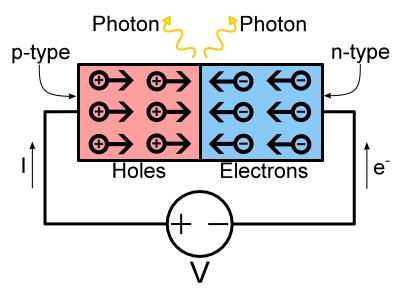
A Schottky diode, also known as a hot carrier diode, is a semiconductor diode which has a low forward voltage drop and a very fast switching action. There is a small voltage drop across the diode terminals when current flows through a diode. A normal diode will have a voltage drop between 0.6 to 1.7 volts, while a Schottky diode voltage drop is usually between 0.15 and 0.45 volts. In this type of diode the junction is formed by contacting the semiconductor material with metal. Due to this the forward voltage drop is decreased to minimum. The semiconductor material is N-type silicon which acts as an anode and the metal acts as a cathode whose materials are chromium, platinum, tungsten etc. Due to the metal junction these diodes have high current conducting capability thus the switching time reduces. So, Schottky has greater use in switching applications. Mainly because of the metal- semiconductor junction the voltage drop is low which in turn increase the diode performance and reduces power loss. So, these are used in high frequency rectifier applications.
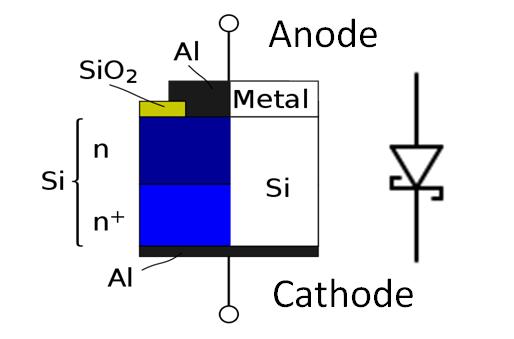
The most common laser diode generates semiconductor or injection laser. In these lasers, a population of Inversion Electrons is produced by applying a voltage across its p-n junction. Laser beam is then available from the semiconductor region. The p-n junction of laser diode has polished ends so that, the emitted photons reflect back and forth and creates more electron-hole pairs. The photons thus generated will be in phase with the previous photons. This will give a Pencil Beam and all the photons in the beam are Coherent and in phase. A laser diode, also known as an injection laser or diode laser, is a semiconductor device that produces coherent radiation (in which the waves are all at the same frequency and phase) in the visible or infrared (IR) spectrum when current passes through it. Laser diodes are used in optical fiber systems, compact disc (CD) players, laser printers, remote-control devices, and intrusion detection systems.
Sections